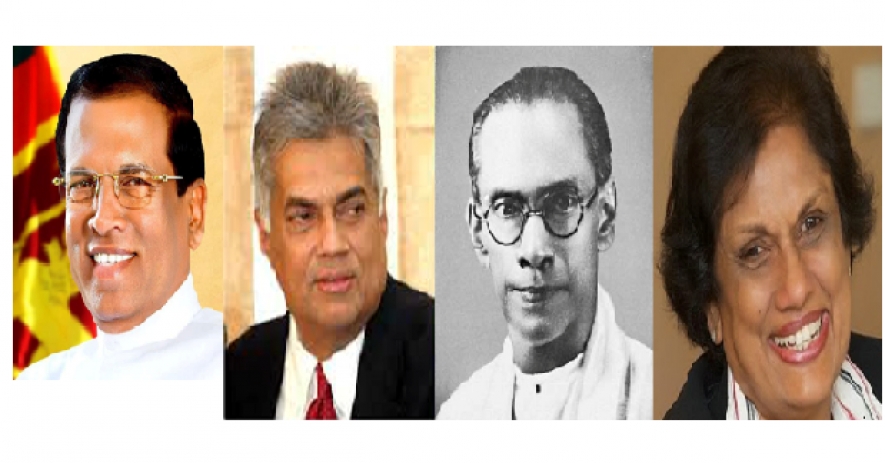Addressing the First Session of the 8th Parliament, President Maithripala Sirisena said as we are living in a globalized new world, every country in the world is important to us. There are many things we can learn from them and they can learn from us, and openness and friendship with all will remain as the foundation of our foreign policy, he added. Pointing out that we have entered the Century of Asia, he said, “My Government will pay more attention towards an Asia-centric middle-path foreign policy.”
What is more important than examining the pros and cons of the new policy at this juncture is to examine how well it is compatible with the foreign policy outlook of the major partner in the government, the United National Party (UNP).
Detailing the foreign policy priorities the President made several interesting remarks. “I believe that during the past few years, the word ‘Geneva’ took up a lot of space in our discourse on foreign policy. From the moment I took office as the President on 8 January, the perspective of the international community towards us has changed in a very positive manner. The faith placed on us by the international community and their cooperation and consensus is very important, when we face the complex situations successfully. I am very happy to state that during the past seven months, my government was able to change the then existed situation towards our country in a positive way while restoring the good name and reputation of the country.”
President Sirisena briefly spelt out the economic benefits of this policy, stating that, “The 21st century is the century of Asia. It is our fortune that we are geographically situated in a position which helps us to get benefits of the economic opportunities generated in a context where Asia is emerging as the hub of the world economy. Our key responsibility is to make future economic policies, plans and strategies in a way to take maximum benefits from this great opportunity endowed upon us by the nature.”
Look East Policy
In the recent past we tried to experiment with a ‘Look East Policy’. In spite of the popular look east option for the countries in South Asia, it would amount to policy myopia of the first order for countries of this region to overlook the need to integrate more fully and dynamically among themselves, in South Asia, first. Such integration at the moment is of the most negligible kind and it would be in the interests of South Asian Association for Regional Cooperation (SAARC) for its members to increasingly strengthen their economic links while looking at growth prospects outside this region.
Unfortunately major SAARC partners have a tendency to look for areas of differences rather than prospects for cooperation. The South Asian nations need to interact with increasing trust and confidence among themselves and should do their best to play down any ‘Big Brother’, ‘Small Brother’ fixations in inter-state relations which have played a considerable role in hampering our regional growth prospects in the past. The need for sustained, region-centred development is felt by both ‘big’ and ‘small’ currently. Inasmuch as the ‘small’ need the ‘big’, the latter too need the former, for, it is to the benefit of the major powers of Asia to have around them countries which prefer ‘to do business’ with them rather than with major economic and military powers outside the Asian region.
Sri Lanka needs to fashion an increasingly Asia-centric foreign policy while attaching equal importance to building and sustaining cordial relations with the West because the latter’s ‘day’ is by no means over. In fact, we need to bear in mind that the major powers of the West, such as the US, are pragmatic in the extreme in their dealings with the predominant economic powers of the Asia-Pacific region. Considerations of political ideology, for instance, have little say, if any, in such ‘East-West’ interactions. A case in point is the US’ relations with China.
Enlightened self-interest
Sri Lanka should approach its tasks in the foreign policy sphere in a spirit of enlightened self-interest. While pursuing the Asia-centric policy, it just would not do for Sri Lanka to fall completely foul of the West. Sri Lanka needs to be truly Non-aligned in fact. Hence the importance of what President Sirisena said about Asia-centric middle path.
When we are in the threshold of the Century of Asia, this continent is of extreme significance for us. At a time when China and India forge ahead, several South-east Asian nations with a strong regional architecture which has helped in maintaining peace as well as enabling economic growth in its region are potential partners for our growth. ASEAN not only stabilized relations among Asian States, but helped them manage regional hegemonic interests from China in the region as well as engage beyond with other strong powers.
There is a gap in South Asia, given the limited powers of SAARC and its inability to gain momentum due to lack of leadership and political will and this gap makes small States like Sri Lanka vulnerable when larger countries such as China show greater interest. Managing to hold onto our sovereignty is crucial in this instance.
It is in this juncture that South-east Asia, as a region, gains significance for Sri Lanka. Unlike in South Asia, South-east Asia has a strong regional architecture which has helped in maintaining peace as well as enabling economic growth in its region.
However, we have to understand our geographical placement and should not make blind attempts to join any groupings elsewhere as we attempted 35 years ago during the UNP Government. In 1978, Sri Lanka made a futile attempt to join ASEAN. Prime Minister Ranasinghe Premadas openly expressed Sri Lanka’s desire to join ASEAN without prior consultations with the group.
The then government instructed the High Commissioner Gunasingham in Singapore to explore the possibilities and he had sent an analysis of the emerging geo-political situation in South-east Asia. In that note he said that he discussed the subject with Thanat Khoman, the then Thai Foreign Minister, who ‘seemed to welcome the idea’ of Sri Lanka’s membership. Gunasingham also felt that other member States were sympathetic to the idea.
Gunasingham got no reply from Colombo. His analysis was that the Government came under pressure from the left parties and also from India ‘which feared that its sphere of influence might be eroded’. China and Soviet Union also opposed the move. Some non-aligned countries also felt that Sri Lanka would be giving up its policy of non-alignment.
Independence in 1948
During the first decade after attaining Independence in 1948, Sri Lankan foreign policy did not differ from that of the United Kingdom. Although the then UNP Leader Sir John Kotelawala was a partner to Bandung Principle of Panchashila, there was no deviation from the pro-British policy until the power shifted to the Sri Lanka Freedom Party (SLFP) of S. W. R. D. Bandaranaike in 1956.
The foreign policy of middle path articulated today by President Sirisena is, in fact is the continuation of the non-aligned policy followed since Bandaranaike era. Mrs. Sirimavo Bandaranaike played a major role in promoting this policy internationally and hosted the Non-aligned Summit in 1976.
However, there were sharp foreign policy disparities between the SLFP and the UNP. In 1977, President J. R. Jayewardene adopted a pro-US policy and later he allowed Israel to set up an Interest Section in the US Embassy in Colombo much to the displeasure of India. Resultant covert and overt assistance to insurgence and attempts to interfere in our internal affairs is history.
President Ranasinghe Premadasa, who assumed office in January 1990 openly confronted India, by giving quit notice to Indian Peace Keeping Force and later earned displeasure of Britain when he declared High Commissioner David Gladstone persona non grata.
President Chandrika Kumaratunga’s regime handled foreign relations with care, without antagonizing either of the big powers or the two Asian giants. However, India was concerned about pro-West tilt when Ranil Wickremesinghe became the Prime Minister in 2001.
Supreme Court
There were expressions of concern in some quarters over the move to give post-Tsunami administrative powers to the Liberation Tigers of Tamil Eelam (LTTE) under the PTOMS pact, which the Supreme Court struck down.
Despite above aberrations, today Sri Lankan leaders have an excellent rapport not only with India, but also with China, the United States, the European Union and Russia. President Sirisena paid his first official visit to India after assuming office and Prime Minister Narendra Modi gave him a grand welcome. During the visit as well as PM Modi’s visit to Sri Lanka later, great personnel rapport in addition to close friendship and the desire to cooperate with each other was quite visible.
Similar affinity was witnessed in President Sirisena’s tour to China and Prime Minister Wickremesinghe’s visits to US and Europe.
Wickremesinghe, as the new Prime Minister too selected India for his first foreign visit, marking the similarity of the foreign policies of the President and the Prime Minister.
In the era of Cold War, it was America’s interest in Sri Lanka that troubled India. However, the US phobia seems to have vanished from the South Block or the Indian Ministry of External Affairs now. But, now the Indians express apprehensions over China’s interest in Sri Lanka. With the change of government in Colombo, India is not overly worried over ‘China factor’.
Whether you talk of global economy or Asian security, it is important to see how China figures in our scheme of affairs. Sri Lanka need not be a satellite State of either China or India, but can continue to strive for a fine balance by managing expectations between the two countries.
In this globalized world, economic and foreign policies are inseparable. China and India are the new heavyweights of the global economy and it would prove prudent for countries, such as Sri Lanka, to increasingly integrate their economies with those of the Asian growth centre, for, global economic prosperity is currently unthinkable without the two Asian giants.
The unique relations that exist among Asian countries have been shaped by close religious, cultural, and linguistic ties. Asians share not only a common continent but share many characteristics such as language, religion, history and culture. For example Buddhist ties spread from Sri Lanka and Burma in South Asia to Thailand, Laos and Cambodia in Southeast Asia and to Japan and China in the Eastern Asia. The robust relationships that exist needs to be fine-tuned along with the changing reality in order to preserve the ‘everlasting peace and friendship’ and also to address newer challenges in the region.




















